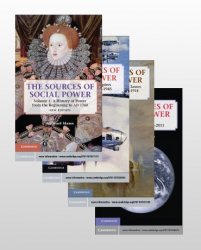
Название: The Sources of Social Power: Vols 1-4, 2nd edition
Автор: Michael Mann
Издательство: Cambridge: Cambridge University Press
Год: 2012-2013
Формат: pdf
Страниц: 578+844+520+496
Размер: 102 mb
Язык: English
Volume 1. A History of Power from the Beginning to AD 1760
Preface to the new edition vii
Preface xxv
1 Societies as organized power networks 1
2 The end of general social evolution: how prehistoric peoples evaded power 34
3 The emergence of stratification, states, and multi-power-actor civilization in Mesopotamia 73
4 A comparative analysis of the emergence of stratification, states, and multi-power-actor civilizations 105
5 The first empires of domination: the dialectics of compulsory cooperation 130
6 “Indo-Europeans” and iron: expanding, diversified power networks 179
7 Phoenicians and Greeks: decentralized multi-power-actor civilizations 190
8 Revitalized empires of domination: Assyria and Persia 231
9 The Roman territorial empire 250
10 Ideology transcendent: the Christian ecumene 301
11 A comparative excursus into the world religions: Confucianism, Islam, and (especially) Hindu caste 341
12 The European dynamic: I. The intensive phase, a.d. 800-1155 373
13 The European dynamic: II. The rise of coordinating states, 1155-1477 416
14 The European dynamic: III. International capitalism and organic national states, 1477-1760 450
15 European conclusions: explaining European dynamism - capitalism, Christendom, and states 500
16 Patterns of world-historical development in agrarian societies 518
Index 543
Volume 2. The Rise of Classes and Nation-States, 1760-1914
Preface to the new edition vii
Preface xix
1 Introduction 1
2 Economic and ideological power relations 23
3 A theory of the modern state 44
4 The Industrial Revolution and old regime liberalism in Britain, 1760-1880 92
5 The American Revolution and the institutionalization of confederal capitalist liberalism 137
6 The French Revolution and the bourgeois nation 167
7 Conclusion to Chapters 4-6: The emergence of classes and nations 214
8 Geopolitics and international capitalism 254
9 Struggle over Germany: I. Prussia and authoritarian national capitalism 297
10 Struggle over Germany: II. Austria and confederal representation 330
11 The rise of the modern state: I. Quantitative data 358
12 The rise of the modern state: II. The autonomy of military power 402
13 The rise of the modern state: III. Bureaucratization 444
14 The rise of the modern state: IV. The expansion of civilian scope 479
15 The resistible rise of the British working class, 1815-1880 510
16 The middle-class nation 546
17 Class struggle in the Second Industrial Revolution, 1880-1914: I. Great Britain 597
18 Class struggle in the Second Industrial Revolution, 1880-1914: II. Comparative analysis of working-class movements 628
19 Class struggle in the Second Industrial Revolution, 1880-1914: III. The peasantry 692
20 Theoretical conclusions: Classes, states, nations, and the sources of social power 723
21 Empirical culmination - over the top: Geopolitics, class struggle, and World War I 740
Appendix Additional tables on state finances and state employment 803
Index 816
Volume 3. Global Empires and Revolution, 1890-1945
Preface vii
1 Introduction 1
2 Globalization imperially fractured: The British Empire 17
3 America and its empire in the Progressive Era, 1890-1930 58
4 Asian empires: Fallen dragon, rising sun 100
5 Half-global crisis: World War I 129
6 Explaining revolutions: Phase 1, proletarian revolutions, 1917-1923 167
7 A half-global crisis: Explaining the Great Depression 208
8 The new deal: America shifts left 241
9 The development of social citizenship in capitalist democracies 280
10 The Fascist alternative, 1918-1945 315
11 The Soviet alternative, 1918-1945 347
12 Japanese imperialism, 1930-1945 371
13 Explaining the Chinese revolution 398
14 The last interimperial war, 1939-1945 423
15 Conclusion 457
Bibliography 467
Index 505
Volume 4. Globalizations, 1945-2011
1 Globalizations 1
2 The postwar global order 13
3 America in war and cold war, 1945-1970: Class conflicts 37
4 U.S. civil rights and identity struggles 67
5 American empire during the cold war, 1945-1980 86
6 Neoliberalism, rise and faltering, 1970-2000 129
7 The fall of the Soviet alternative 179
8 The Maoist alternative reformed 218
9 A theory of revolution 246
10 American empire at the turn of the twenty-first century 268
11 Global crisis: The great neoliberal recession 322
12 Global crisis: Climate change 361
13 Conclusion 400
Bibliography 433
Index 469
[related-news] [/related-news]
Комментарии 0
Комментариев пока нет. Стань первым!















